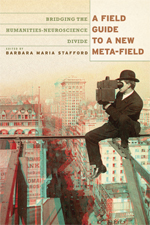Barbara Maria Stafford, ed. Bridging the Humanities-Neuroscience Divide: A Field Guide to a New Meta-Field. Chicago: University of Chicago Press, 2011.
 When I saw the title of this book on the Internet, I was sure this was something important for me to read. I was not mistaken. Here is an extraordinary scholarly contribution to the development and explorations of frameworks that address the fragmentation of knowledge and research that has both served and detracted from the efficacy of higher education. Specifically, Stafford and her fellow authors do not claim to have accomplished a new theory of everything. Rather, they are exploring the world of theory in relation to bridging the distance between science and the humanities. More specifically, the connection between the arts and neuroscience is a central focus.
When I saw the title of this book on the Internet, I was sure this was something important for me to read. I was not mistaken. Here is an extraordinary scholarly contribution to the development and explorations of frameworks that address the fragmentation of knowledge and research that has both served and detracted from the efficacy of higher education. Specifically, Stafford and her fellow authors do not claim to have accomplished a new theory of everything. Rather, they are exploring the world of theory in relation to bridging the distance between science and the humanities. More specifically, the connection between the arts and neuroscience is a central focus.
I also approach this work with some trepidation, concerned that I do not have the depth of background in either the neurosciences or the humanities to qualify me to review the book. So please take this as a brief report. If there is anyone out there who wishes to take on an in depth review of the book, I will get a copy to you.
Barbara Maria Stafford, a professor at the University of Chicago, has an extraordinary reputation as a scholar, which she gives credence to in her opening chapter of this series of excursions. The title of her chapter, “Crystal and Smoke: Putting Image Back in Mind,” hints at a major interest of mine – one that I am only beginning to explore – namely, how our minds interact with images, both real and imagined, to shape our sense and meaning making. Stafford’s focus is on mind-artifact relations.
In the latter sentence, one can already begin to sense how this work extends primitive notions about artifacts as being piles in our world and life. Rather, it is in the dialogical engagement of our minds with out contexts that generates sense and meaning in our lives. The aesthetic of art, then, “has long located art within a science of sensuous knowing,” (1) Many developmental lines are suggested by this observation, including “the intelligence lodged in the body (that is, in visual, kenaesthetic, haptic, acoustic, olfactory, and visceral sensations)…”(1) Such observations are developmentally relevant and that which is developmentally relevant is important for individual development and effectively fulfilling leader roles.
Returning to Stafford, she is exploring “how to inlay research coming from the humanities and social sciences with that coming from the emerging brain sciences to mutual benefit.” (2) This is an appeal to a transdisciplinary approach without dismissing lower levels of theory and research. From her work we derive another notion that strips away the oversimplification of integral notions of lines of development: the intertwining of lines. For example, there is a fundamental link between creativity and memory. These, in turn, are related to other lines, including social cognition. The exchanges among these and other lines are dialogical and embodied. She notes, “social cognition evolves from the emulative and empathetic exchange with other members of a group or tribe.” (11) And we develop meaning through pattern recognition and pattern generation in that dialogical dance.
Stafford also raises the question of design:
A key future direction in transdisciplinary design, then, would not just probe isolated cells or objects, but capture them during simultaneous activity. The design of sycretic formats that pull the essential our of multimodal patterns and tie them together has thus become critical in information processing across the board. (11)
This and others of her observations lead me to wonder how we design interventions to communicate generative developmental aspirations, vision, while speaking to vmemetic cores? Stafford expands her discussion to the relationship between vision and language, working her way toward questions of how our visual snapshots and movies are influenced by the language we use.
“The intractable [the snapshot] and the undulating [the movie] are complementary modes of imaging. They communicate two fundamental ways of always forming forms: the forceful seizure of shape and the leisurely pursuit of taking shape.” Again, an important nuace in how we make sense and meaning of leadership.
These and other themes are addressed in the extraordinary navigation for discovery of not only how we make sense and meaning and its dialogical nature, but how can we conceive of these by building an understanding of the interactions of art, social science and neuroscience.
